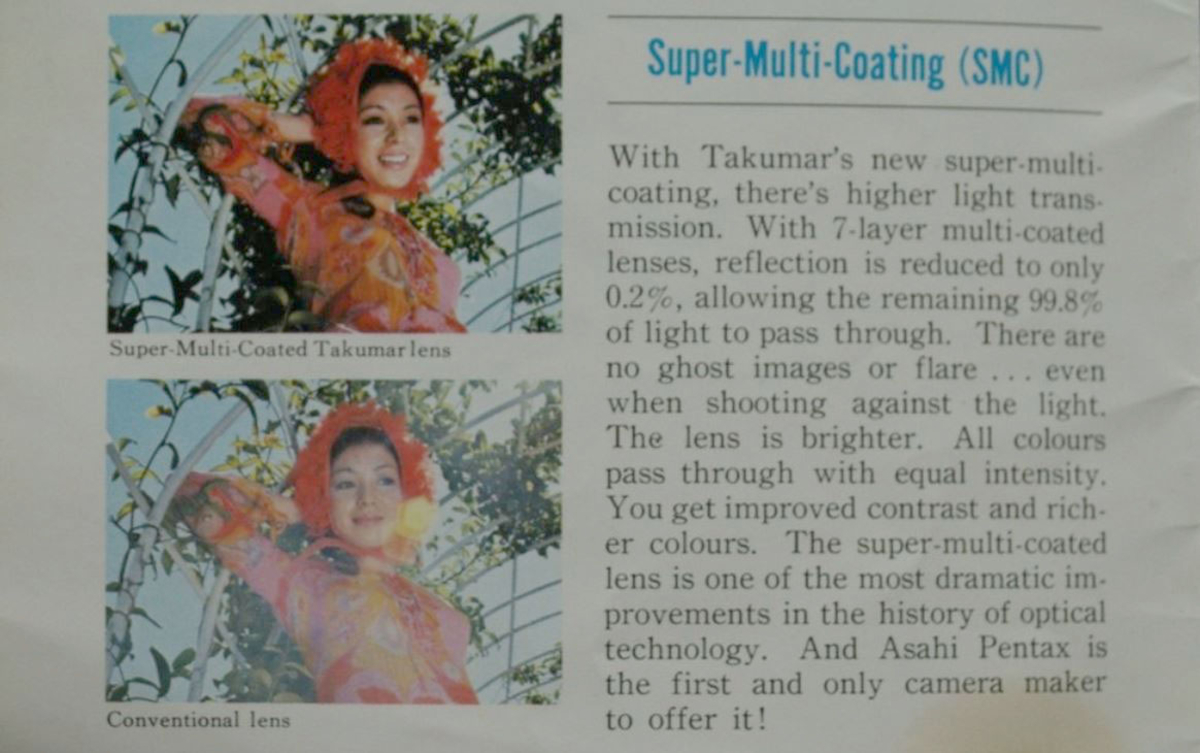Hier von
recht bekannten Quelle:
About Super-Multi Coating (SMC)
Refraction and Partial Reflection
Light refracts (bends) when it travels through a border between two transparent substances with different densities. In particular, it bends when leaving air and entering glass and also when leaving glass and entering air. Under ideal conditions all light will bend, but in real life about 95% bends and 5% is reflected back into the first substance.
With photographic lenses this is a serious problem because less light reaches the film surface. For a lens with n optical groups (hence 2n refraction surfaces) and coefficient of refraction r (the percentage of refracted light divided by 100), only a fraction L reaches the film, and L = r 2n. For r = 0.95 and n = 10, L = 0.36. This means that only 36% of the light reaches the film. The rest is scattered around, and some of it results in undesirable ghost images or flare.
Super Multi-Coating
To combat the undesirable consequences of partial reflection, scientists developed chemical coatings to be applied to glass surfaces. These coatings increase r, and in the case of Pentax's famous Super Multi-Coating (SMC), r = 0.998! Performing the above calculation for a lens with 10 groups, we get L = 0.96, or only 4% light loss.
SMC was patented and first applied in 1971, when Pentax was still making screw mount equipment. To highlight the fact that the lens elements were super multi-coated, Pentax renamed their lens lines from Takumar and Super-Takumar to Super-Multi-Coated Takumar and later on to SMC Takumar.
Nowadays, with K-mount equipment, SMC is used for lens, filters, some body optics and various accessories. Most Pentax lenses are SMC-coated. All SMC-coated lenses have "SMC" in their name. The few lenses that do not have SMC are low-budget items, and bear no "SMC" in their name. They all have some form of coating, some of them even multi-layer, but not the patented SMC.
Benefits from SMC
In reference 06671, Pentax claims that SMC is "a remarkable seven-layer lens coating process that cuts the reflection ratio down to just 0.2% per lens surface. The result is a dramatic improvement in both color fidelity and brightness and the elimination of flare and ghost images."
In the meantime, all optics manufacturers have developed some form of surface coating, and each claims "superior performance." In practice, most tests point that Pentax's SMC is still the best of all mainstream solutions.
Ghostless Coating
In 1997 Pentax released the FA 43/1.9 Limited lens — the first lens to feature the newly-developed ghostless coating. This coating formula is an improvement over SMC, and like its name suggests, it is extremely successful at eliminating ghost images. If one believes the rumors, the new coating was developed for an automated traffic-identification system. It was ordered by the Japanese police who was having problems identifying car license-plates at night due to flare caused by the cars' headlights.
Since 1997 Pentax has applied ghostless coating only on several "selected" lenses, which probably means that its application process is more expensive than that of SMC.Die Darlegung ist aber nicht ganz korrekt:
Super Multi-Coating und SMC sind nicht 100% identisch!
Begonnen hat diese Beschichtung mit den Takumaren nach der "Super-Takumar"-Epoche.
Die ersten nannten sich noch
"Multicoated Super Takumar", abgelöst dann von den "S-M-C" = Super Multi Coated
und dann erst kam SMC.
Niemand weiss so genau, was die Unterschiede sind, aber z.B. ist das Multicoated Super Takumar 50mm/f1,4 offiziell kein S-M-C aber von der Beschichtung her schon.
Das spätere SMC 50mm/1,4 Takumar war auch optisch völlig anders!
Es gibt einen Unterschied zwischen den S-M-C und SMC!
Die SMC Beschichtung wurde dann 1:1 mit der SMC Serie, die man jetzt SMC K nennt (da die ersten mit K-Bajonett) übernommen.
Hinzu kommt, dass die US-Amerikaner die Super-Multi-Coated (S-M-C) Takumare mit "SMC" bezeichneten, während die Japaner das damals noch "S-M-C" nannten:

(Siehe auch Herbert Keppler "The Asahi Pentax Way" S. 95)
Die Ghostlessbeschichtung, die zuerst bei den FA-Limiteds eingesetzt wurde (bei dem SMC DA Limiteds fortgeführt) gab es auch bei wenigen Nicht-Limited Objektiven:
- FA28-105mm/f3,2 IF (ein schwieriges Objektiv, da sehr leicht gebaut, der AF kann es recht hart an beide Enden knallen lassen, aber sonst richtig gut und natürlich Vollformat)
- FA24-90mm/3,5-4,5AL (IF)
- DA35mm/f2,4: Die frühen waren alle ghostless beschichtet
- DA50mm/f1,8: auch hier wenige frühe, die aus Japan kamen
Zudem gab es von Asahi damals auch noch den 49mm Ghostless UV-Filter, der den anderen UV Filtern (bei Film) überlegen war aber nichts mit der Ghostless-Beschichtung der Objektive zu tun hat. Auch nicht zu verwechseln mit dem alten Hama Ghostless UV-Filter, der etwas gewölbt war.
Mehr zur Geschichte und auch den Lügen, die es zu den S-M-C und SMC Beschichtungen gab
Ich habe das vor längerer Zeit mal geschrieben. Insbesondere die Schwindeleien von Fabio Amodeo hatte ich sehr genau recherchiert, habe aber leider keine links mehr dazu.
Ich kann aber versichern, dass ich all diese Veröffentlichungen von Amodeo gelesen und geprüft hatte!



